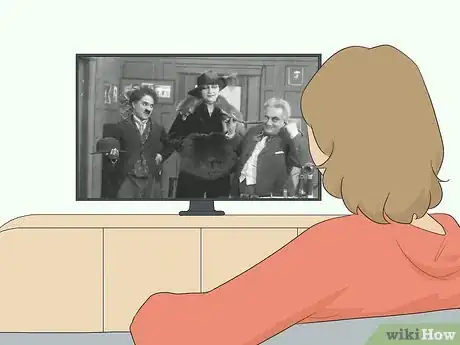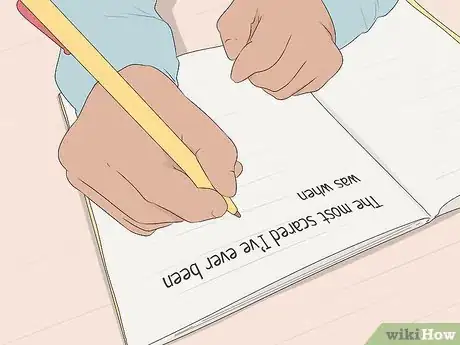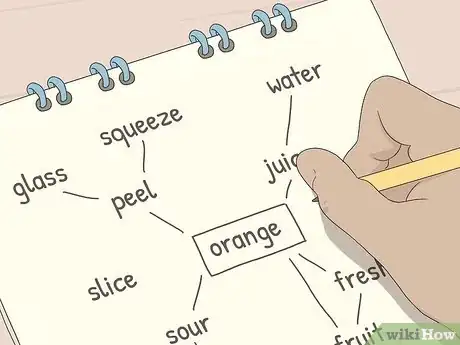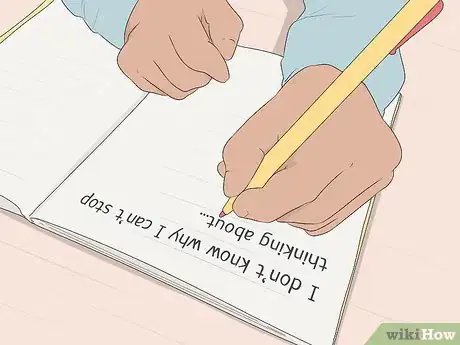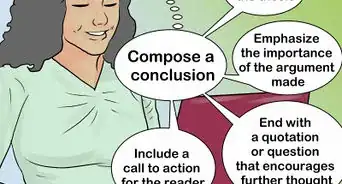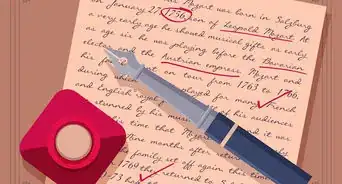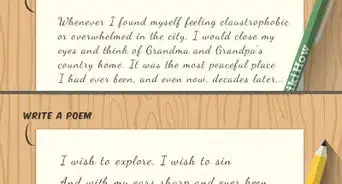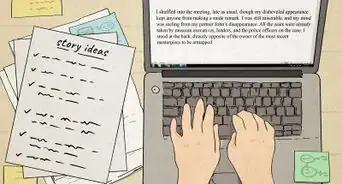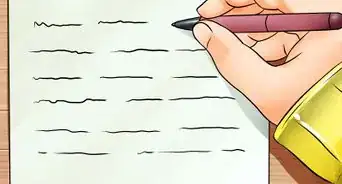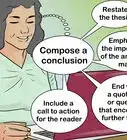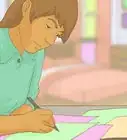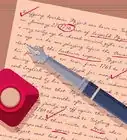This article was co-authored by Grant Faulkner, MA. Grant Faulkner is the Executive Director of National Novel Writing Month (NaNoWriMo) and the co-founder of 100 Word Story, a literary magazine. Grant has published two books on writing and has been published in The New York Times and Writer’s Digest. He co-hosts Write-minded, a weekly podcast on writing and publishing, and has a M.A. in Creative Writing from San Francisco State University.
There are 15 references cited in this article, which can be found at the bottom of the page.
wikiHow marks an article as reader-approved once it receives enough positive feedback. This article received 13 testimonials and 100% of readers who voted found it helpful, earning it our reader-approved status.
This article has been viewed 141,699 times.
Writers of fiction, poetry, TV and movie scripts, song lyrics, and even advertisements rely on their ability to come up with ideas and put them into words. Consistently coming up with ideas for creative writing can be challenging, but there are ways to stimulate your creativity and avoid writer's block. Try some of the following methods to get your creative juices flowing!
Steps
Using your Experience
-
1Ask "what if".[1] Take elements of something that happened to you or someone you know and consider how things would have played out if circumstances had been different.
- For example, if you talked your mother out of going to the grocery store after noticing ominous clouds on your way home from school, imagine how your life would have been different if your mother had gone to the store and it was demolished by the tornado.
-
2Watch people. Go somewhere public where you can observe people coming and going, such as a shopping mall, nightclub, or auditorium. As you watch them, ask journalist questions to yourself about them. Where are they going? What are they doing? Where did they come from? Do they have a family? What do they enjoy doing? What do they hate?[2]Advertisement
-
3Log your experiences. Whether you call it a log, journal, or diary, recording your daily experiences with other people, places, and events gives you a written resource to draw from whenever you need story ideas.[3] The more detail you put in your journal when writing down your experiences, the more detail you can take from them and put into your story, enhancing its believability.
-
4Get together with other writers.[4] Spending time with other writers, either by participating in a writing group or by taking a creative writing class, gives you the chance to bounce ideas off other people and draw support from them. Another person's perspective may be enough to encourage you to accept the idea that's been kicking around in your head and run with it, or you can trade story ideas you can't develop for ideas your fellow writers can't develop but that you can.[5]
Drawing Inspiration from Existing Stories
-
1Read widely. Good writers are good readers.[6] Not only can you keep abreast of trends in your writing specialty and see examples of other writers' styles, but you can also find story ideas from what you read, whether in newspapers, magazines, books, or online.
- Other works of fiction can serve as inspiration for your stories, as well. Scholars have cited the influence of the Scandinavian legend of Amleth and the Roman tale of Brutus on Hamlet.[7]
- You can also base a creative writing idea on a quote. The classic "Star Trek" episode "The Conscience of the King," featuring the exposure of a former dictator, who had tried to atone for his past by leading an acting troupe, takes its title from a line in "Hamlet": "The play's the thing wherein I'll catch the conscience of the king."[8]
-
2Pay attention to current events. If readers recognize the connection between your story and something from everyday life, they will be more likely to empathize with your characters and appreciate your story more.
- Reading a newspaper, news magazine, or news website on a regular basis can provide you with a steady stream of story ideas in the form of news events. Many episodes in the "Law and Order" franchise were based on contemporary news headlines.[9] Some English scholars and historians argue that Shakespeare's "Hamlet" was inspired by the life of King James I. You'll have to change some of the elements in the real story for your fictionalized versions in order to avoid scandalizing real people.
-
3Watch movies or TV. If you are writing for a popular audience, see what is popular on the big screen or on your television screen. Think about topics in the same genre as other popular movies or shows.
-
4Listen to music.[10] Musicians draw from everyday experience or classic themes. Build off your favorite song. Maybe listen to a Tupac song and write about gang violence. Maybe listen to a Joni Mitchell song and write about environmental issues. Listen to all kinds of music even if you don't consider a genre to be for you.
-
5Do research. If you think you are interested in writing about a subject, learn more about it. You might just learn an interesting detail that will form the kernel of your entire creative writing piece.[11]
- Look through dictionaries, encyclopedias, and even thesauruses. You may come across a word, idea, or event that will spark your imagination.[12]
Free-forming Ideas
-
1Use a story starter. In some cases, you don't need to reinvent the wheel. Others have created lists of great story ideas for you to build off. [13] Story starters or story prompts are pre-written scenarios or phrases you can use as jumping-off points for stories. You can find story starters as exercises in writing classes, in writing group newsletters, or online.
-
2Use word association. Pick a word (e.g. farm, president, chalk, hungry, daughter...etc.). It doesn't matter what that word is. Then write down as many words that relate to it. [14]
- For a fixed period of time. Set a timer for 5 to 15 minutes, then write down as many story ideas as you can think of before the timer sounds.
- Challenge yourself to write down a large number of ideas, such as 50 to 100. Keep writing ideas down until you've met your goal. You can also challenge yourself to write this many ideas for a fixed period of time, provided you allot yourself a reasonable amount of time to do so.
- Be sure to allow yourself enough time and put in enough effort to come up with a reasonable amount of possible ideas. In most brainstorming sessions, the majority of your ideas won't be worth pursuing. Keep at it.
- Whichever brainstorming method you use, don't stop along the way to evaluate the ideas you've generated until your time is up or your goal is met. At that point, you can then review the lists you've made and pick out what works best to you. You can also then identify any related ideas and see if they generate any additional ideas.
- For instance, you could begin with the word "storm". Then you list words that relate to "storm" like: wind, water, damage, clouds, danger...etc. Then pair one of those words with your original and try to tell a story about it.
-
3Build on a randomly chosen element. Take the name of a person or place from the newspaper, the phone book, or somewhere else and then imagine what he, she, or it would look like.
- Build a backstory. For a person, this would include information about their line of work, friends, family, aspirations, and fears. For a place, you could discuss the area's geography, local history, population, and wildlife. Then, add an element of conflict, a problem that plagues the person or happens in the place you've created. Build a story about what happens as a result.[15]
- Write backwards. Alternatively, you may know the outcome of a story. Now make a list of possible reasons why the character is so angry. Choose the most interesting possibilities and flesh them out, defining the event that triggered the rage and the prior events that led to it. Add more specifics to each step until you finally have the elements of a story.
-
4Pretend you're telling the story to someone else. Instead of trying to write the story right away, act as though you're talking to somebody else, either by carrying on a conversation in your head or by talking into a recording device. Try to think of what questions another person might have about your idea or story. Transcribe the results of that conversation onto the page.
-
5Think about your audience. For whom are you writing this piece? You will choose topics differently if you are writing for adults vs children, Americans vs Canadians, highbrow vs lowbrow people, or men vs women. Try to think about your audience's preferences and then go from there.[16]
-
6Identify your purpose for writing. Are you trying to entertain? Are you trying to inform? If you can identify why you are writing something, you can build off that initial inspiration.[17]
Taking Strategic Breaks
-
1Try writing a different piece of work. If you're having trouble coming up with an idea for a particular story, try working on a different story, a different part of the story, or a different kind of writing altogether. Changing what you're working on might free you up to come up with ideas for your original story.
- If you are working on a short story idea, stop and write a poem, a review of a television show, or even just a list of words. It is important to get your mental juices flowing and writing anything is better than becoming frustrated with yourself.
-
2Allow yourself time away from writing. You know when inspiration will strike. Get away from your paper or keyboard. Your brain will continue to churn out ideas or will draw inspiration from something. Even though Isaac Asimov wrote 10 hours a day, 7 days a week, he found the time to attend science fiction conventions, carry on correspondence with friends, and flirt with women.
-
3Exercise. If you're feeling sluggish while struggling to come up with ideas, take a few minutes to get some physical exercise, either by exercising for its own sake or by doing a household chore that requires some effort for a short period of time. At the end of that time, you'll feel more alert and the ideas will come easier.
-
4Nap. If exercising only wears you down, perhaps you should instead take a nap. A short nap of 30 minutes or less will be enough to give you a rest and may be enough to let an idea come to you. Longer naps of up to 90 minutes may allow you to enter REM sleep and give you the opportunity to dream up a story idea.
- Use a dream. If you've recently had a dream and remember it, write some ideas of it down on a piece of paper and jumble them all up to whatever you want it to be or whatever feels right to you, this should give you some ideas to write a story in the future.
- Edgar Allen Poe drew inspiration from nightmares for much of his poetry.[18]
- According to his claims on the 25th anniversary of publishing his 1865 paper on the ring-like structure of benzene, chemist Friedrich August Kekule claimed to have daydreamed seeing a snake grab its tail, which inspired him to interpret his research as he did.[19]
Community Q&A
-
QuestionWhat if my dreams are boring, or have copyrighted characters in them?
 PamelaCommunity AnswerIf you have boring dreams at night, do not use them. Instead, use your daydreams to craft a story special to you.
PamelaCommunity AnswerIf you have boring dreams at night, do not use them. Instead, use your daydreams to craft a story special to you. -
QuestionHow do I carry one era to present day?
 Community AnswerLabelling each scene with the date and location helps carry time transitions. For example, one scene could be "A hundred years ago, Virginia" and the next could be labelled as "Now, Virginia". Also, flashbacks can be used to describe a character's past.
Community AnswerLabelling each scene with the date and location helps carry time transitions. For example, one scene could be "A hundred years ago, Virginia" and the next could be labelled as "Now, Virginia". Also, flashbacks can be used to describe a character's past. -
QuestionIs becoming a writer is a good career?
 Community AnswerSure. Many writers find success financially and on a passionate level.
Community AnswerSure. Many writers find success financially and on a passionate level.
References
- ↑ http://www.sparringmind.com/creative-thinking/
- ↑ http://www.creative-writing-now.com/writing-journal.html
- ↑ http://www.creative-writing-now.com/writing-journal.html
- ↑ http://www.writers-network.com
- ↑ http://www.creative-writing-now.com
- ↑ Grant Faulkner, MA. Professional Writer. Expert Interview. 8 January 2019.
- ↑ http://internetshakespeare.uvic.ca/Library/SLT/history/prehistory/amleth.html
- ↑ http://en.memory-alpha.org/wiki/The_Conscience_of_the_King_(episode)
- ↑ http://www.businessinsider.com/real-crimes-that-inspired-law-and-order-episodes-2012-3
- ↑ http://www.build-creative-writing-ideas.com/free-creative-writing-prompts-music.html
- ↑ http://www.dailywritingtips.com/5-brainstorming-strategies-for-writers/
- ↑ http://writingcenter.unc.edu/handouts/brainstorming/
- ↑ http://www.creative-writing-now.com/story-starters.html
- ↑ http://www.dailywritingtips.com/5-brainstorming-strategies-for-writers/
- ↑ https://owl.english.purdue.edu/owl/resource/754/01/
- ↑ http://writingcenter.unc.edu/handouts/brainstorming/
- ↑ http://writingcenter.unc.edu/handouts/brainstorming/
- ↑ http://www.huffingtonpost.com/2013/11/16/famous-ideas-from-dreams_n_4276838.html
- ↑ http://www.britannica.com/EBchecked/topic/314308/August-Kekule-von-Stradonitz







